iPhone Xi Strategic Marketing Plan: Vietnam Market Entry - Apple
VerifiedAdded on 2023/07/12
|26
|5662
|315
Report
AI Summary
This report presents a strategic marketing plan for Apple's iPhone Xi in the Vietnamese market, considering the evolving smartphone landscape and Apple's long-term goals. It includes a background on Apple's existing markets and customers, followed by external (PESTLE and Porter's Five Forces) and internal (SWOT) situation analyses. The PESTLE analysis covers political, economic, socio-cultural, technological, ecological, and legal factors influencing Apple's operations in Vietnam. Porter's Five Forces examines the competitive rivalry, bargaining power of customers and suppliers, threat of substitutes, and threat of new entrants. The SWOT analysis identifies Apple's strengths, weaknesses, opportunities, and threats in the Vietnamese market. Based on these analyses, the report outlines a marketing plan for the iPhone Xi, focusing on leveraging Apple's strengths and addressing market challenges to achieve specific marketing objectives, such as increased brand recognition and consumer loyalty.
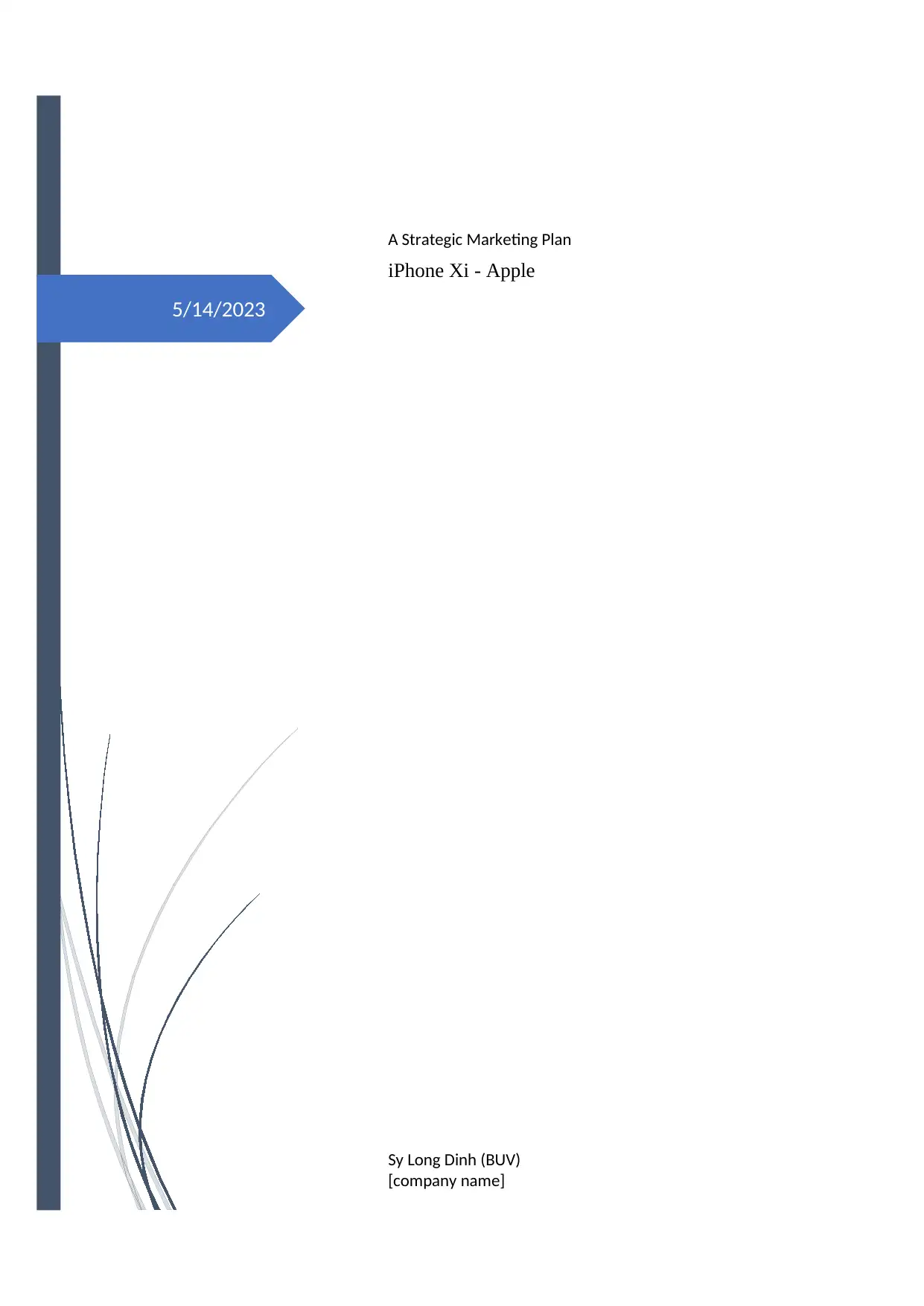
5/14/2023
A Strategic Marketing Plan
iPhone Xi - Apple
Sy Long Dinh (BUV)
[company name]
A Strategic Marketing Plan
iPhone Xi - Apple
Sy Long Dinh (BUV)
[company name]
Paraphrase This Document
Need a fresh take? Get an instant paraphrase of this document with our AI Paraphraser
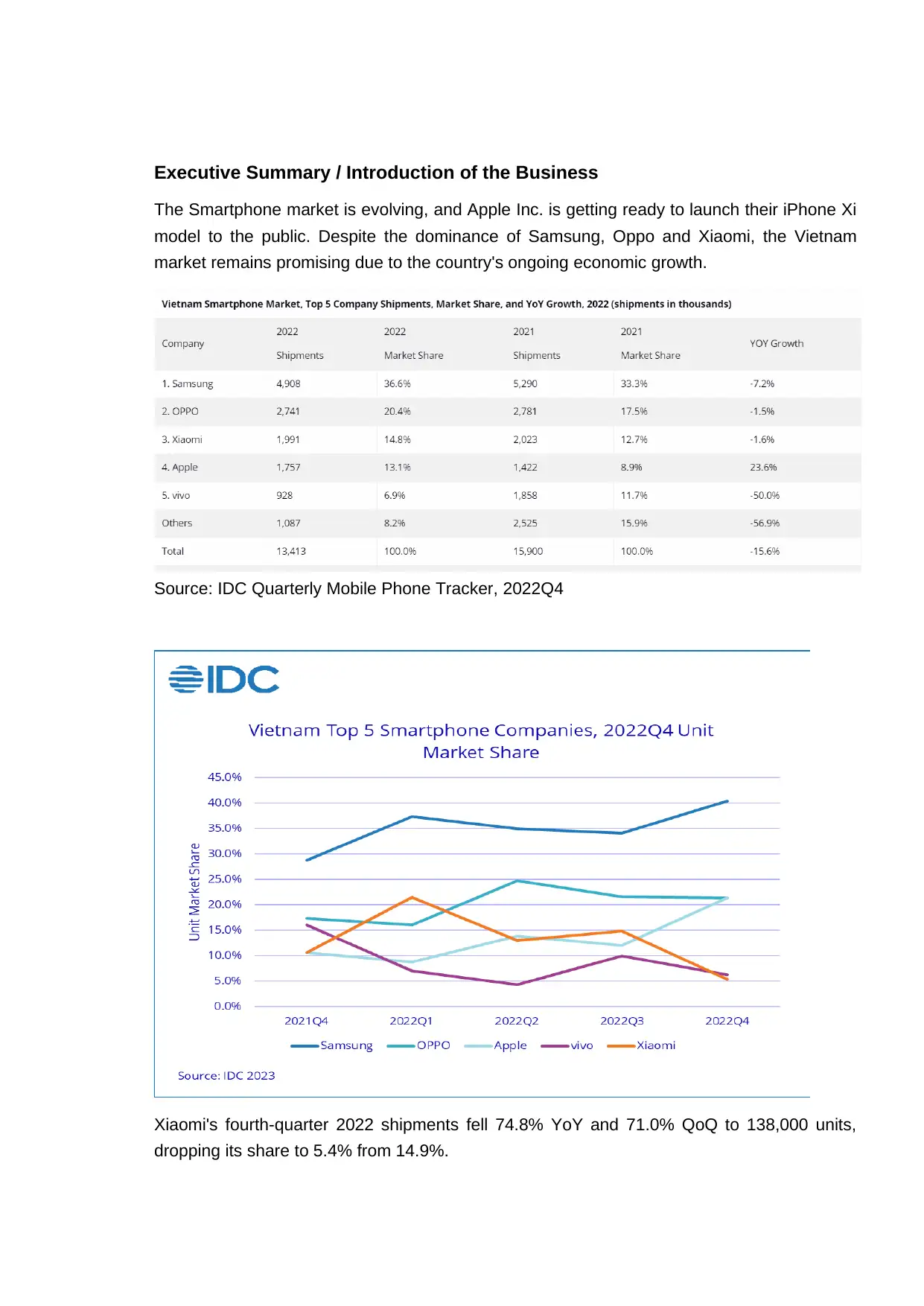
Executive Summary / Introduction of the Business
The Smartphone market is evolving, and Apple Inc. is getting ready to launch their iPhone Xi
model to the public. Despite the dominance of Samsung, Oppo and Xiaomi, the Vietnam
market remains promising due to the country's ongoing economic growth.
Source: IDC Quarterly Mobile Phone Tracker, 2022Q4
Xiaomi's fourth-quarter 2022 shipments fell 74.8% YoY and 71.0% QoQ to 138,000 units,
dropping its share to 5.4% from 14.9%.
The Smartphone market is evolving, and Apple Inc. is getting ready to launch their iPhone Xi
model to the public. Despite the dominance of Samsung, Oppo and Xiaomi, the Vietnam
market remains promising due to the country's ongoing economic growth.
Source: IDC Quarterly Mobile Phone Tracker, 2022Q4
Xiaomi's fourth-quarter 2022 shipments fell 74.8% YoY and 71.0% QoQ to 138,000 units,
dropping its share to 5.4% from 14.9%.
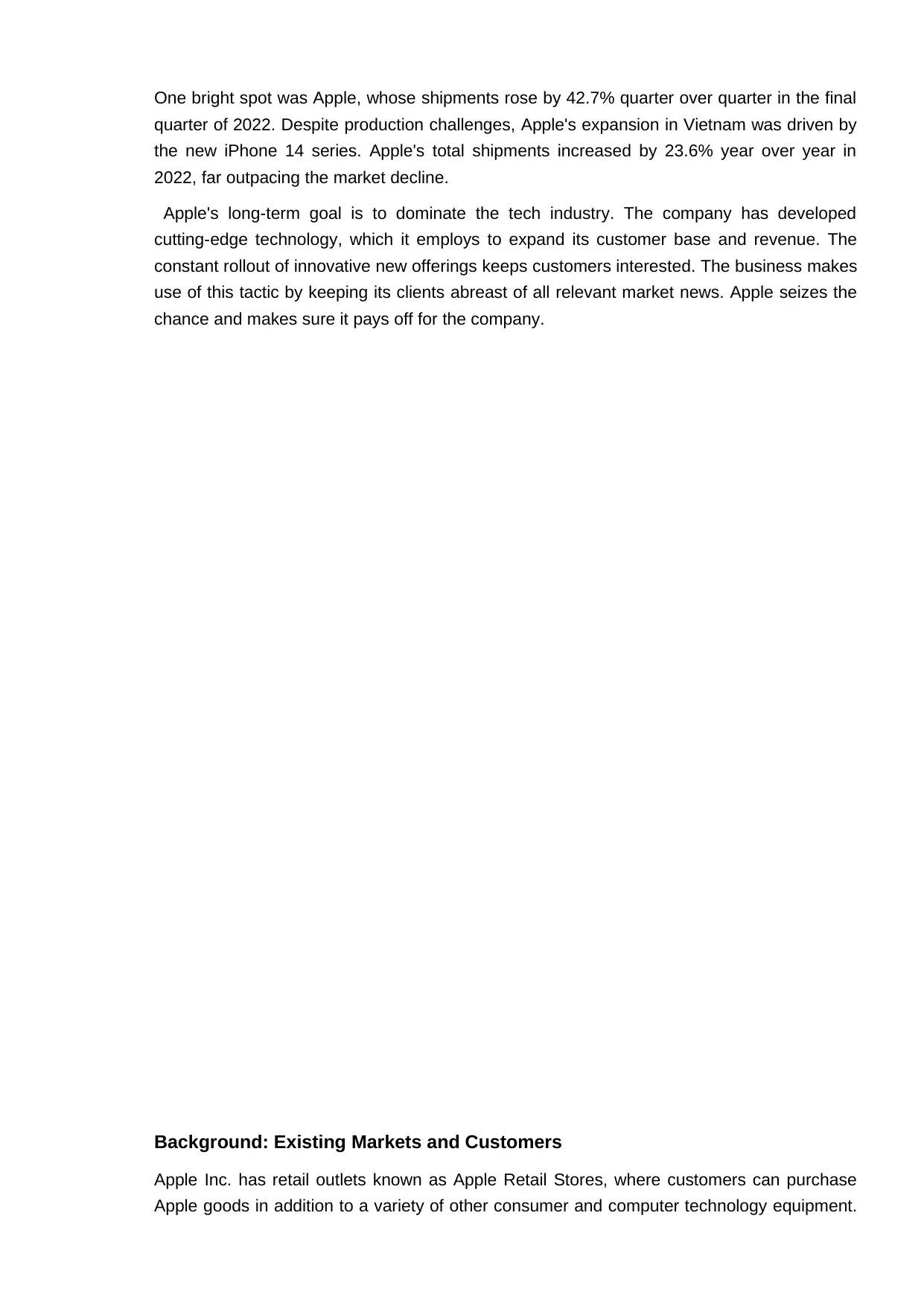
One bright spot was Apple, whose shipments rose by 42.7% quarter over quarter in the final
quarter of 2022. Despite production challenges, Apple's expansion in Vietnam was driven by
the new iPhone 14 series. Apple's total shipments increased by 23.6% year over year in
2022, far outpacing the market decline.
Apple's long-term goal is to dominate the tech industry. The company has developed
cutting-edge technology, which it employs to expand its customer base and revenue. The
constant rollout of innovative new offerings keeps customers interested. The business makes
use of this tactic by keeping its clients abreast of all relevant market news. Apple seizes the
chance and makes sure it pays off for the company.
Background: Existing Markets and Customers
Apple Inc. has retail outlets known as Apple Retail Stores, where customers can purchase
Apple goods in addition to a variety of other consumer and computer technology equipment.
quarter of 2022. Despite production challenges, Apple's expansion in Vietnam was driven by
the new iPhone 14 series. Apple's total shipments increased by 23.6% year over year in
2022, far outpacing the market decline.
Apple's long-term goal is to dominate the tech industry. The company has developed
cutting-edge technology, which it employs to expand its customer base and revenue. The
constant rollout of innovative new offerings keeps customers interested. The business makes
use of this tactic by keeping its clients abreast of all relevant market news. Apple seizes the
chance and makes sure it pays off for the company.
Background: Existing Markets and Customers
Apple Inc. has retail outlets known as Apple Retail Stores, where customers can purchase
Apple goods in addition to a variety of other consumer and computer technology equipment.
⊘ This is a preview!⊘
Do you want full access?
Subscribe today to unlock all pages.

Trusted by 1+ million students worldwide
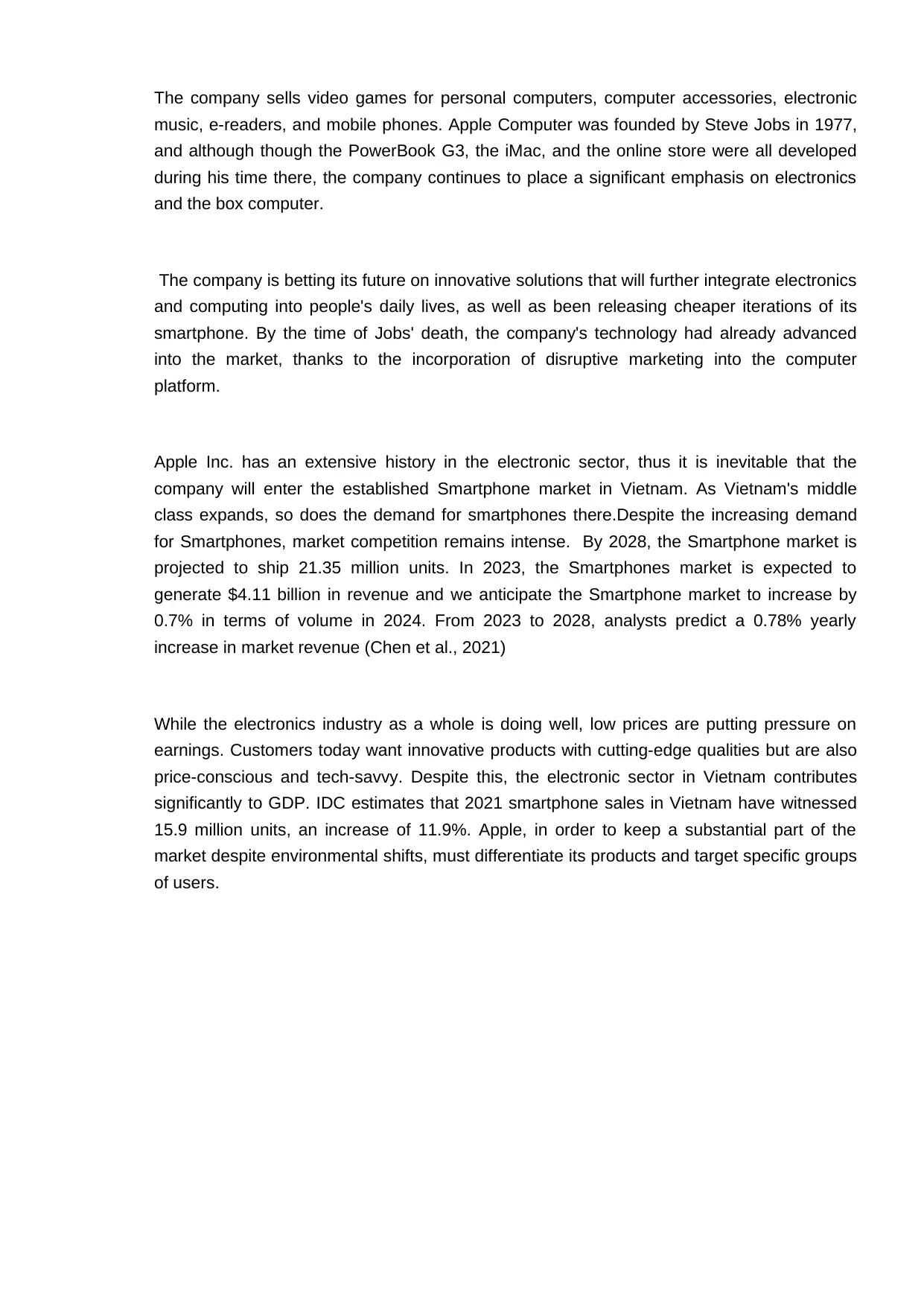
The company sells video games for personal computers, computer accessories, electronic
music, e-readers, and mobile phones. Apple Computer was founded by Steve Jobs in 1977,
and although though the PowerBook G3, the iMac, and the online store were all developed
during his time there, the company continues to place a significant emphasis on electronics
and the box computer.
The company is betting its future on innovative solutions that will further integrate electronics
and computing into people's daily lives, as well as been releasing cheaper iterations of its
smartphone. By the time of Jobs' death, the company's technology had already advanced
into the market, thanks to the incorporation of disruptive marketing into the computer
platform.
Apple Inc. has an extensive history in the electronic sector, thus it is inevitable that the
company will enter the established Smartphone market in Vietnam. As Vietnam's middle
class expands, so does the demand for smartphones there.Despite the increasing demand
for Smartphones, market competition remains intense. By 2028, the Smartphone market is
projected to ship 21.35 million units. In 2023, the Smartphones market is expected to
generate $4.11 billion in revenue and we anticipate the Smartphone market to increase by
0.7% in terms of volume in 2024. From 2023 to 2028, analysts predict a 0.78% yearly
increase in market revenue (Chen et al., 2021)
While the electronics industry as a whole is doing well, low prices are putting pressure on
earnings. Customers today want innovative products with cutting-edge qualities but are also
price-conscious and tech-savvy. Despite this, the electronic sector in Vietnam contributes
significantly to GDP. IDC estimates that 2021 smartphone sales in Vietnam have witnessed
15.9 million units, an increase of 11.9%. Apple, in order to keep a substantial part of the
market despite environmental shifts, must differentiate its products and target specific groups
of users.
music, e-readers, and mobile phones. Apple Computer was founded by Steve Jobs in 1977,
and although though the PowerBook G3, the iMac, and the online store were all developed
during his time there, the company continues to place a significant emphasis on electronics
and the box computer.
The company is betting its future on innovative solutions that will further integrate electronics
and computing into people's daily lives, as well as been releasing cheaper iterations of its
smartphone. By the time of Jobs' death, the company's technology had already advanced
into the market, thanks to the incorporation of disruptive marketing into the computer
platform.
Apple Inc. has an extensive history in the electronic sector, thus it is inevitable that the
company will enter the established Smartphone market in Vietnam. As Vietnam's middle
class expands, so does the demand for smartphones there.Despite the increasing demand
for Smartphones, market competition remains intense. By 2028, the Smartphone market is
projected to ship 21.35 million units. In 2023, the Smartphones market is expected to
generate $4.11 billion in revenue and we anticipate the Smartphone market to increase by
0.7% in terms of volume in 2024. From 2023 to 2028, analysts predict a 0.78% yearly
increase in market revenue (Chen et al., 2021)
While the electronics industry as a whole is doing well, low prices are putting pressure on
earnings. Customers today want innovative products with cutting-edge qualities but are also
price-conscious and tech-savvy. Despite this, the electronic sector in Vietnam contributes
significantly to GDP. IDC estimates that 2021 smartphone sales in Vietnam have witnessed
15.9 million units, an increase of 11.9%. Apple, in order to keep a substantial part of the
market despite environmental shifts, must differentiate its products and target specific groups
of users.
Paraphrase This Document
Need a fresh take? Get an instant paraphrase of this document with our AI Paraphraser
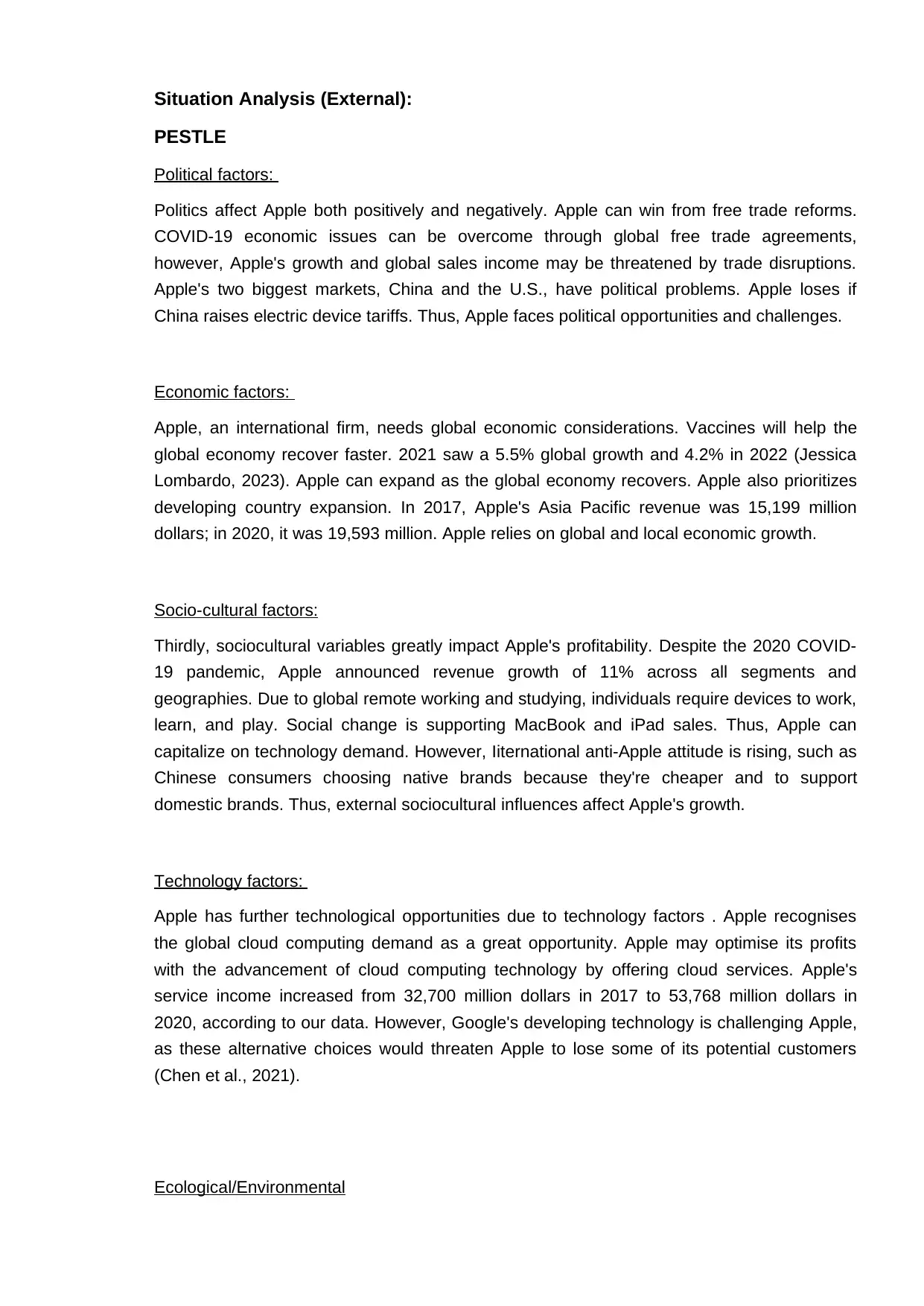
Situation Analysis (External):
PESTLE
Political factors:
Politics affect Apple both positively and negatively. Apple can win from free trade reforms.
COVID-19 economic issues can be overcome through global free trade agreements,
however, Apple's growth and global sales income may be threatened by trade disruptions.
Apple's two biggest markets, China and the U.S., have political problems. Apple loses if
China raises electric device tariffs. Thus, Apple faces political opportunities and challenges.
Economic factors:
Apple, an international firm, needs global economic considerations. Vaccines will help the
global economy recover faster. 2021 saw a 5.5% global growth and 4.2% in 2022 (Jessica
Lombardo, 2023). Apple can expand as the global economy recovers. Apple also prioritizes
developing country expansion. In 2017, Apple's Asia Pacific revenue was 15,199 million
dollars; in 2020, it was 19,593 million. Apple relies on global and local economic growth.
Socio-cultural factors:
Thirdly, sociocultural variables greatly impact Apple's profitability. Despite the 2020 COVID-
19 pandemic, Apple announced revenue growth of 11% across all segments and
geographies. Due to global remote working and studying, individuals require devices to work,
learn, and play. Social change is supporting MacBook and iPad sales. Thus, Apple can
capitalize on technology demand. However, Iiternational anti-Apple attitude is rising, such as
Chinese consumers choosing native brands because they're cheaper and to support
domestic brands. Thus, external sociocultural influences affect Apple's growth.
Technology factors:
Apple has further technological opportunities due to technology factors . Apple recognises
the global cloud computing demand as a great opportunity. Apple may optimise its profits
with the advancement of cloud computing technology by offering cloud services. Apple's
service income increased from 32,700 million dollars in 2017 to 53,768 million dollars in
2020, according to our data. However, Google's developing technology is challenging Apple,
as these alternative choices would threaten Apple to lose some of its potential customers
(Chen et al., 2021).
Ecological/Environmental
PESTLE
Political factors:
Politics affect Apple both positively and negatively. Apple can win from free trade reforms.
COVID-19 economic issues can be overcome through global free trade agreements,
however, Apple's growth and global sales income may be threatened by trade disruptions.
Apple's two biggest markets, China and the U.S., have political problems. Apple loses if
China raises electric device tariffs. Thus, Apple faces political opportunities and challenges.
Economic factors:
Apple, an international firm, needs global economic considerations. Vaccines will help the
global economy recover faster. 2021 saw a 5.5% global growth and 4.2% in 2022 (Jessica
Lombardo, 2023). Apple can expand as the global economy recovers. Apple also prioritizes
developing country expansion. In 2017, Apple's Asia Pacific revenue was 15,199 million
dollars; in 2020, it was 19,593 million. Apple relies on global and local economic growth.
Socio-cultural factors:
Thirdly, sociocultural variables greatly impact Apple's profitability. Despite the 2020 COVID-
19 pandemic, Apple announced revenue growth of 11% across all segments and
geographies. Due to global remote working and studying, individuals require devices to work,
learn, and play. Social change is supporting MacBook and iPad sales. Thus, Apple can
capitalize on technology demand. However, Iiternational anti-Apple attitude is rising, such as
Chinese consumers choosing native brands because they're cheaper and to support
domestic brands. Thus, external sociocultural influences affect Apple's growth.
Technology factors:
Apple has further technological opportunities due to technology factors . Apple recognises
the global cloud computing demand as a great opportunity. Apple may optimise its profits
with the advancement of cloud computing technology by offering cloud services. Apple's
service income increased from 32,700 million dollars in 2017 to 53,768 million dollars in
2020, according to our data. However, Google's developing technology is challenging Apple,
as these alternative choices would threaten Apple to lose some of its potential customers
(Chen et al., 2021).
Ecological/Environmental
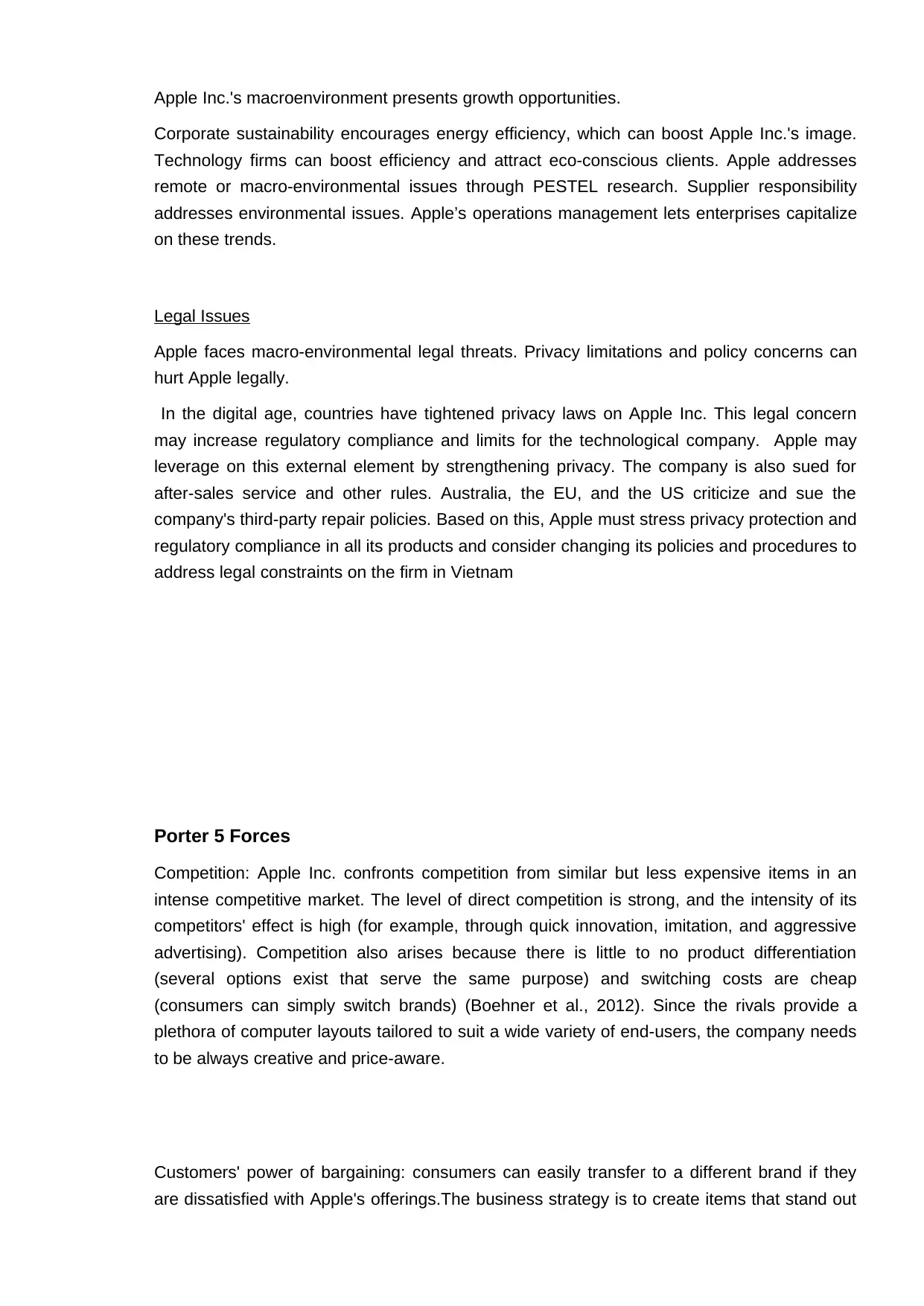
Apple Inc.'s macroenvironment presents growth opportunities.
Corporate sustainability encourages energy efficiency, which can boost Apple Inc.'s image.
Technology firms can boost efficiency and attract eco-conscious clients. Apple addresses
remote or macro-environmental issues through PESTEL research. Supplier responsibility
addresses environmental issues. Apple’s operations management lets enterprises capitalize
on these trends.
Legal Issues
Apple faces macro-environmental legal threats. Privacy limitations and policy concerns can
hurt Apple legally.
In the digital age, countries have tightened privacy laws on Apple Inc. This legal concern
may increase regulatory compliance and limits for the technological company. Apple may
leverage on this external element by strengthening privacy. The company is also sued for
after-sales service and other rules. Australia, the EU, and the US criticize and sue the
company's third-party repair policies. Based on this, Apple must stress privacy protection and
regulatory compliance in all its products and consider changing its policies and procedures to
address legal constraints on the firm in Vietnam
Porter 5 Forces
Competition: Apple Inc. confronts competition from similar but less expensive items in an
intense competitive market. The level of direct competition is strong, and the intensity of its
competitors' effect is high (for example, through quick innovation, imitation, and aggressive
advertising). Competition also arises because there is little to no product differentiation
(several options exist that serve the same purpose) and switching costs are cheap
(consumers can simply switch brands) (Boehner et al., 2012). Since the rivals provide a
plethora of computer layouts tailored to suit a wide variety of end-users, the company needs
to be always creative and price-aware.
Customers' power of bargaining: consumers can easily transfer to a different brand if they
are dissatisfied with Apple's offerings.The business strategy is to create items that stand out
Corporate sustainability encourages energy efficiency, which can boost Apple Inc.'s image.
Technology firms can boost efficiency and attract eco-conscious clients. Apple addresses
remote or macro-environmental issues through PESTEL research. Supplier responsibility
addresses environmental issues. Apple’s operations management lets enterprises capitalize
on these trends.
Legal Issues
Apple faces macro-environmental legal threats. Privacy limitations and policy concerns can
hurt Apple legally.
In the digital age, countries have tightened privacy laws on Apple Inc. This legal concern
may increase regulatory compliance and limits for the technological company. Apple may
leverage on this external element by strengthening privacy. The company is also sued for
after-sales service and other rules. Australia, the EU, and the US criticize and sue the
company's third-party repair policies. Based on this, Apple must stress privacy protection and
regulatory compliance in all its products and consider changing its policies and procedures to
address legal constraints on the firm in Vietnam
Porter 5 Forces
Competition: Apple Inc. confronts competition from similar but less expensive items in an
intense competitive market. The level of direct competition is strong, and the intensity of its
competitors' effect is high (for example, through quick innovation, imitation, and aggressive
advertising). Competition also arises because there is little to no product differentiation
(several options exist that serve the same purpose) and switching costs are cheap
(consumers can simply switch brands) (Boehner et al., 2012). Since the rivals provide a
plethora of computer layouts tailored to suit a wide variety of end-users, the company needs
to be always creative and price-aware.
Customers' power of bargaining: consumers can easily transfer to a different brand if they
are dissatisfied with Apple's offerings.The business strategy is to create items that stand out
⊘ This is a preview!⊘
Do you want full access?
Subscribe today to unlock all pages.

Trusted by 1+ million students worldwide
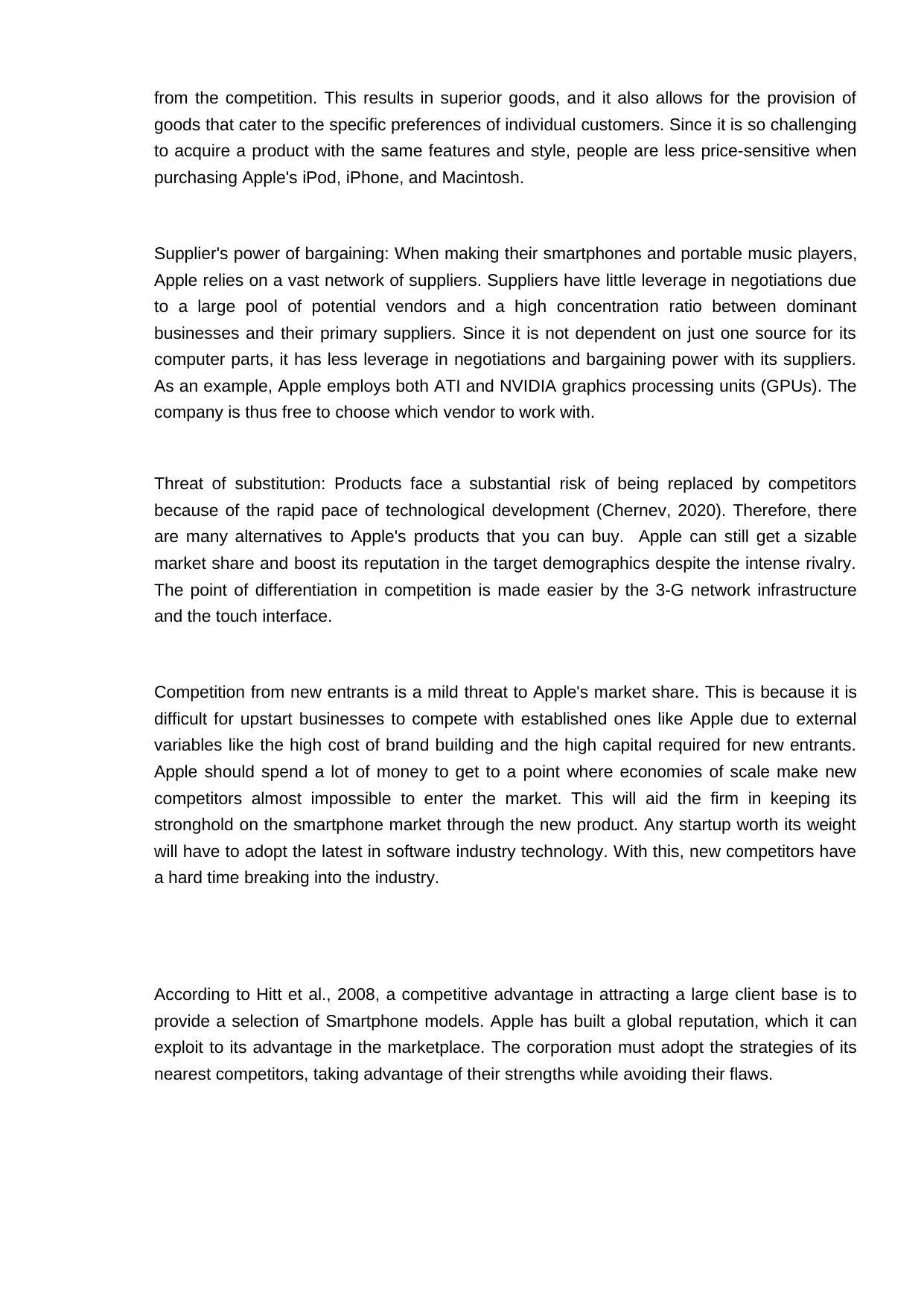
from the competition. This results in superior goods, and it also allows for the provision of
goods that cater to the specific preferences of individual customers. Since it is so challenging
to acquire a product with the same features and style, people are less price-sensitive when
purchasing Apple's iPod, iPhone, and Macintosh.
Supplier's power of bargaining: When making their smartphones and portable music players,
Apple relies on a vast network of suppliers. Suppliers have little leverage in negotiations due
to a large pool of potential vendors and a high concentration ratio between dominant
businesses and their primary suppliers. Since it is not dependent on just one source for its
computer parts, it has less leverage in negotiations and bargaining power with its suppliers.
As an example, Apple employs both ATI and NVIDIA graphics processing units (GPUs). The
company is thus free to choose which vendor to work with.
Threat of substitution: Products face a substantial risk of being replaced by competitors
because of the rapid pace of technological development (Chernev, 2020). Therefore, there
are many alternatives to Apple's products that you can buy. Apple can still get a sizable
market share and boost its reputation in the target demographics despite the intense rivalry.
The point of differentiation in competition is made easier by the 3-G network infrastructure
and the touch interface.
Competition from new entrants is a mild threat to Apple's market share. This is because it is
difficult for upstart businesses to compete with established ones like Apple due to external
variables like the high cost of brand building and the high capital required for new entrants.
Apple should spend a lot of money to get to a point where economies of scale make new
competitors almost impossible to enter the market. This will aid the firm in keeping its
stronghold on the smartphone market through the new product. Any startup worth its weight
will have to adopt the latest in software industry technology. With this, new competitors have
a hard time breaking into the industry.
According to Hitt et al., 2008, a competitive advantage in attracting a large client base is to
provide a selection of Smartphone models. Apple has built a global reputation, which it can
exploit to its advantage in the marketplace. The corporation must adopt the strategies of its
nearest competitors, taking advantage of their strengths while avoiding their flaws.
goods that cater to the specific preferences of individual customers. Since it is so challenging
to acquire a product with the same features and style, people are less price-sensitive when
purchasing Apple's iPod, iPhone, and Macintosh.
Supplier's power of bargaining: When making their smartphones and portable music players,
Apple relies on a vast network of suppliers. Suppliers have little leverage in negotiations due
to a large pool of potential vendors and a high concentration ratio between dominant
businesses and their primary suppliers. Since it is not dependent on just one source for its
computer parts, it has less leverage in negotiations and bargaining power with its suppliers.
As an example, Apple employs both ATI and NVIDIA graphics processing units (GPUs). The
company is thus free to choose which vendor to work with.
Threat of substitution: Products face a substantial risk of being replaced by competitors
because of the rapid pace of technological development (Chernev, 2020). Therefore, there
are many alternatives to Apple's products that you can buy. Apple can still get a sizable
market share and boost its reputation in the target demographics despite the intense rivalry.
The point of differentiation in competition is made easier by the 3-G network infrastructure
and the touch interface.
Competition from new entrants is a mild threat to Apple's market share. This is because it is
difficult for upstart businesses to compete with established ones like Apple due to external
variables like the high cost of brand building and the high capital required for new entrants.
Apple should spend a lot of money to get to a point where economies of scale make new
competitors almost impossible to enter the market. This will aid the firm in keeping its
stronghold on the smartphone market through the new product. Any startup worth its weight
will have to adopt the latest in software industry technology. With this, new competitors have
a hard time breaking into the industry.
According to Hitt et al., 2008, a competitive advantage in attracting a large client base is to
provide a selection of Smartphone models. Apple has built a global reputation, which it can
exploit to its advantage in the marketplace. The corporation must adopt the strategies of its
nearest competitors, taking advantage of their strengths while avoiding their flaws.
Paraphrase This Document
Need a fresh take? Get an instant paraphrase of this document with our AI Paraphraser
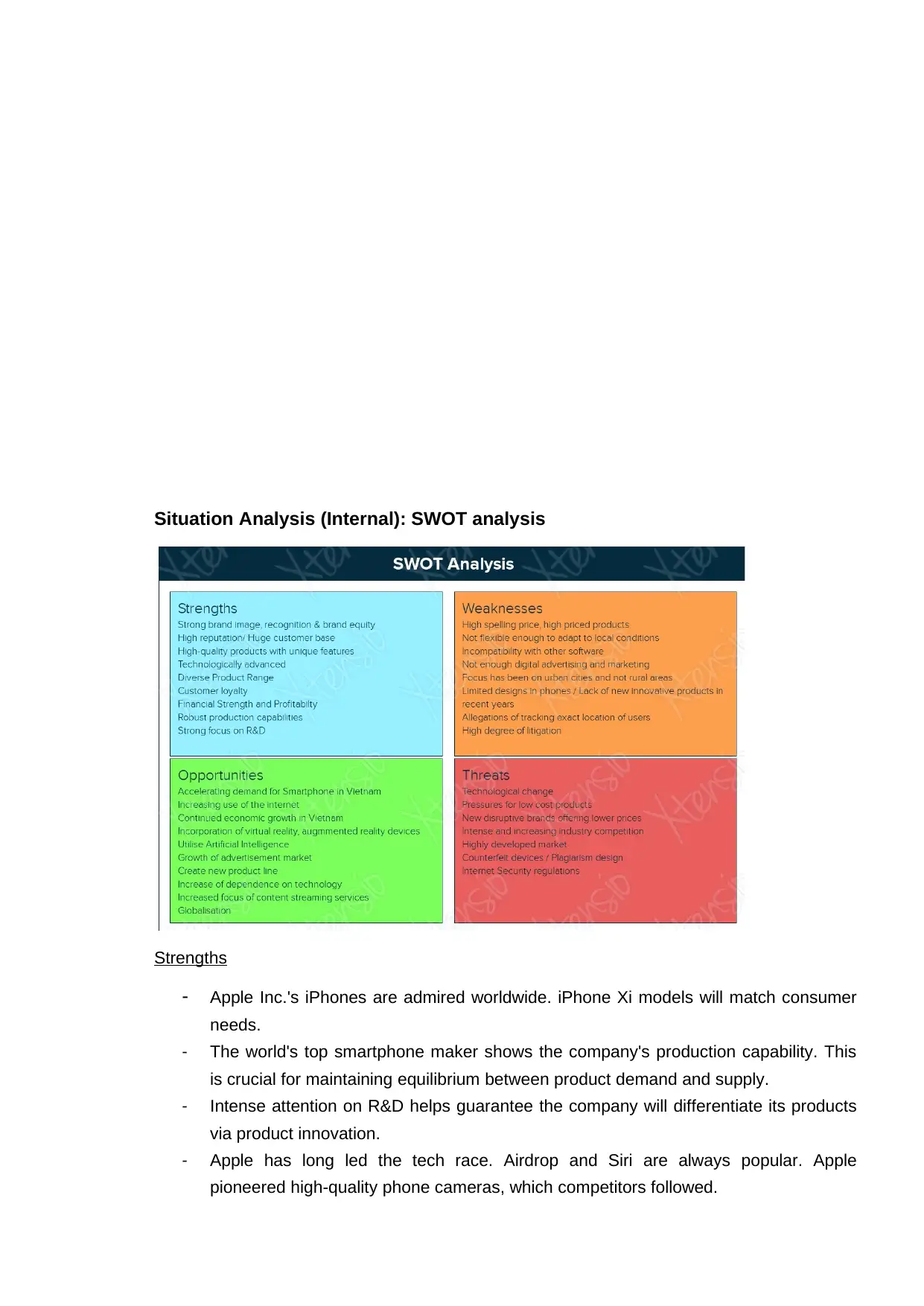
Situation Analysis (Internal): SWOT analysis
Strengths
- Apple Inc.'s iPhones are admired worldwide. iPhone Xi models will match consumer
needs.
- The world's top smartphone maker shows the company's production capability. This
is crucial for maintaining equilibrium between product demand and supply.
- Intense attention on R&D helps guarantee the company will differentiate its products
via product innovation.
- Apple has long led the tech race. Airdrop and Siri are always popular. Apple
pioneered high-quality phone cameras, which competitors followed.
Strengths
- Apple Inc.'s iPhones are admired worldwide. iPhone Xi models will match consumer
needs.
- The world's top smartphone maker shows the company's production capability. This
is crucial for maintaining equilibrium between product demand and supply.
- Intense attention on R&D helps guarantee the company will differentiate its products
via product innovation.
- Apple has long led the tech race. Airdrop and Siri are always popular. Apple
pioneered high-quality phone cameras, which competitors followed.
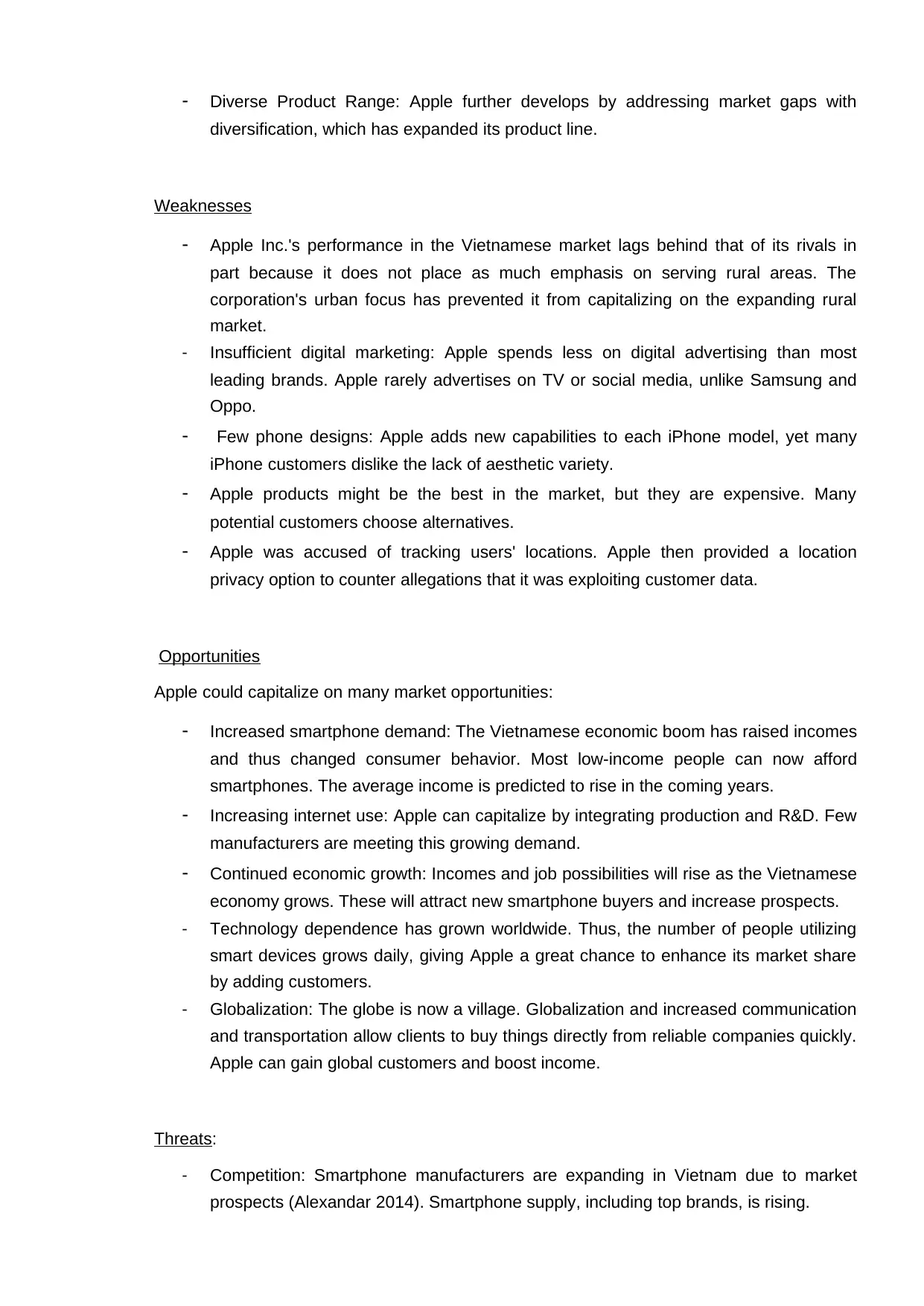
- Diverse Product Range: Apple further develops by addressing market gaps with
diversification, which has expanded its product line.
Weaknesses
- Apple Inc.'s performance in the Vietnamese market lags behind that of its rivals in
part because it does not place as much emphasis on serving rural areas. The
corporation's urban focus has prevented it from capitalizing on the expanding rural
market.
- Insufficient digital marketing: Apple spends less on digital advertising than most
leading brands. Apple rarely advertises on TV or social media, unlike Samsung and
Oppo.
- Few phone designs: Apple adds new capabilities to each iPhone model, yet many
iPhone customers dislike the lack of aesthetic variety.
- Apple products might be the best in the market, but they are expensive. Many
potential customers choose alternatives.
- Apple was accused of tracking users' locations. Apple then provided a location
privacy option to counter allegations that it was exploiting customer data.
Opportunities
Apple could capitalize on many market opportunities:
- Increased smartphone demand: The Vietnamese economic boom has raised incomes
and thus changed consumer behavior. Most low-income people can now afford
smartphones. The average income is predicted to rise in the coming years.
- Increasing internet use: Apple can capitalize by integrating production and R&D. Few
manufacturers are meeting this growing demand.
- Continued economic growth: Incomes and job possibilities will rise as the Vietnamese
economy grows. These will attract new smartphone buyers and increase prospects.
- Technology dependence has grown worldwide. Thus, the number of people utilizing
smart devices grows daily, giving Apple a great chance to enhance its market share
by adding customers.
- Globalization: The globe is now a village. Globalization and increased communication
and transportation allow clients to buy things directly from reliable companies quickly.
Apple can gain global customers and boost income.
Threats:
- Competition: Smartphone manufacturers are expanding in Vietnam due to market
prospects (Alexandar 2014). Smartphone supply, including top brands, is rising.
diversification, which has expanded its product line.
Weaknesses
- Apple Inc.'s performance in the Vietnamese market lags behind that of its rivals in
part because it does not place as much emphasis on serving rural areas. The
corporation's urban focus has prevented it from capitalizing on the expanding rural
market.
- Insufficient digital marketing: Apple spends less on digital advertising than most
leading brands. Apple rarely advertises on TV or social media, unlike Samsung and
Oppo.
- Few phone designs: Apple adds new capabilities to each iPhone model, yet many
iPhone customers dislike the lack of aesthetic variety.
- Apple products might be the best in the market, but they are expensive. Many
potential customers choose alternatives.
- Apple was accused of tracking users' locations. Apple then provided a location
privacy option to counter allegations that it was exploiting customer data.
Opportunities
Apple could capitalize on many market opportunities:
- Increased smartphone demand: The Vietnamese economic boom has raised incomes
and thus changed consumer behavior. Most low-income people can now afford
smartphones. The average income is predicted to rise in the coming years.
- Increasing internet use: Apple can capitalize by integrating production and R&D. Few
manufacturers are meeting this growing demand.
- Continued economic growth: Incomes and job possibilities will rise as the Vietnamese
economy grows. These will attract new smartphone buyers and increase prospects.
- Technology dependence has grown worldwide. Thus, the number of people utilizing
smart devices grows daily, giving Apple a great chance to enhance its market share
by adding customers.
- Globalization: The globe is now a village. Globalization and increased communication
and transportation allow clients to buy things directly from reliable companies quickly.
Apple can gain global customers and boost income.
Threats:
- Competition: Smartphone manufacturers are expanding in Vietnam due to market
prospects (Alexandar 2014). Smartphone supply, including top brands, is rising.
⊘ This is a preview!⊘
Do you want full access?
Subscribe today to unlock all pages.

Trusted by 1+ million students worldwide
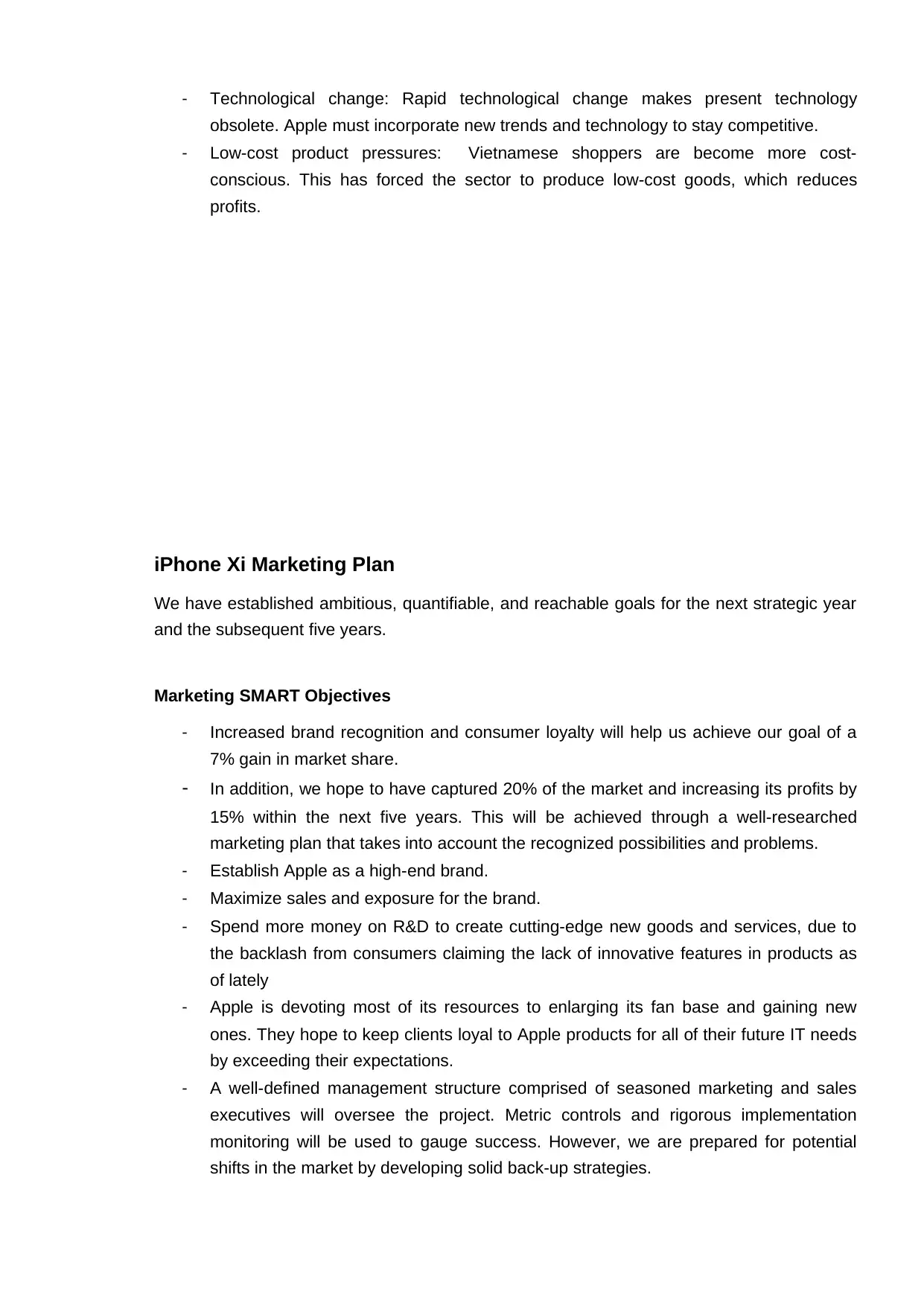
- Technological change: Rapid technological change makes present technology
obsolete. Apple must incorporate new trends and technology to stay competitive.
- Low-cost product pressures: Vietnamese shoppers are become more cost-
conscious. This has forced the sector to produce low-cost goods, which reduces
profits.
iPhone Xi Marketing Plan
We have established ambitious, quantifiable, and reachable goals for the next strategic year
and the subsequent five years.
Marketing SMART Objectives
- Increased brand recognition and consumer loyalty will help us achieve our goal of a
7% gain in market share.
- In addition, we hope to have captured 20% of the market and increasing its profits by
15% within the next five years. This will be achieved through a well-researched
marketing plan that takes into account the recognized possibilities and problems.
- Establish Apple as a high-end brand.
- Maximize sales and exposure for the brand.
- Spend more money on R&D to create cutting-edge new goods and services, due to
the backlash from consumers claiming the lack of innovative features in products as
of lately
- Apple is devoting most of its resources to enlarging its fan base and gaining new
ones. They hope to keep clients loyal to Apple products for all of their future IT needs
by exceeding their expectations.
- A well-defined management structure comprised of seasoned marketing and sales
executives will oversee the project. Metric controls and rigorous implementation
monitoring will be used to gauge success. However, we are prepared for potential
shifts in the market by developing solid back-up strategies.
obsolete. Apple must incorporate new trends and technology to stay competitive.
- Low-cost product pressures: Vietnamese shoppers are become more cost-
conscious. This has forced the sector to produce low-cost goods, which reduces
profits.
iPhone Xi Marketing Plan
We have established ambitious, quantifiable, and reachable goals for the next strategic year
and the subsequent five years.
Marketing SMART Objectives
- Increased brand recognition and consumer loyalty will help us achieve our goal of a
7% gain in market share.
- In addition, we hope to have captured 20% of the market and increasing its profits by
15% within the next five years. This will be achieved through a well-researched
marketing plan that takes into account the recognized possibilities and problems.
- Establish Apple as a high-end brand.
- Maximize sales and exposure for the brand.
- Spend more money on R&D to create cutting-edge new goods and services, due to
the backlash from consumers claiming the lack of innovative features in products as
of lately
- Apple is devoting most of its resources to enlarging its fan base and gaining new
ones. They hope to keep clients loyal to Apple products for all of their future IT needs
by exceeding their expectations.
- A well-defined management structure comprised of seasoned marketing and sales
executives will oversee the project. Metric controls and rigorous implementation
monitoring will be used to gauge success. However, we are prepared for potential
shifts in the market by developing solid back-up strategies.
Paraphrase This Document
Need a fresh take? Get an instant paraphrase of this document with our AI Paraphraser
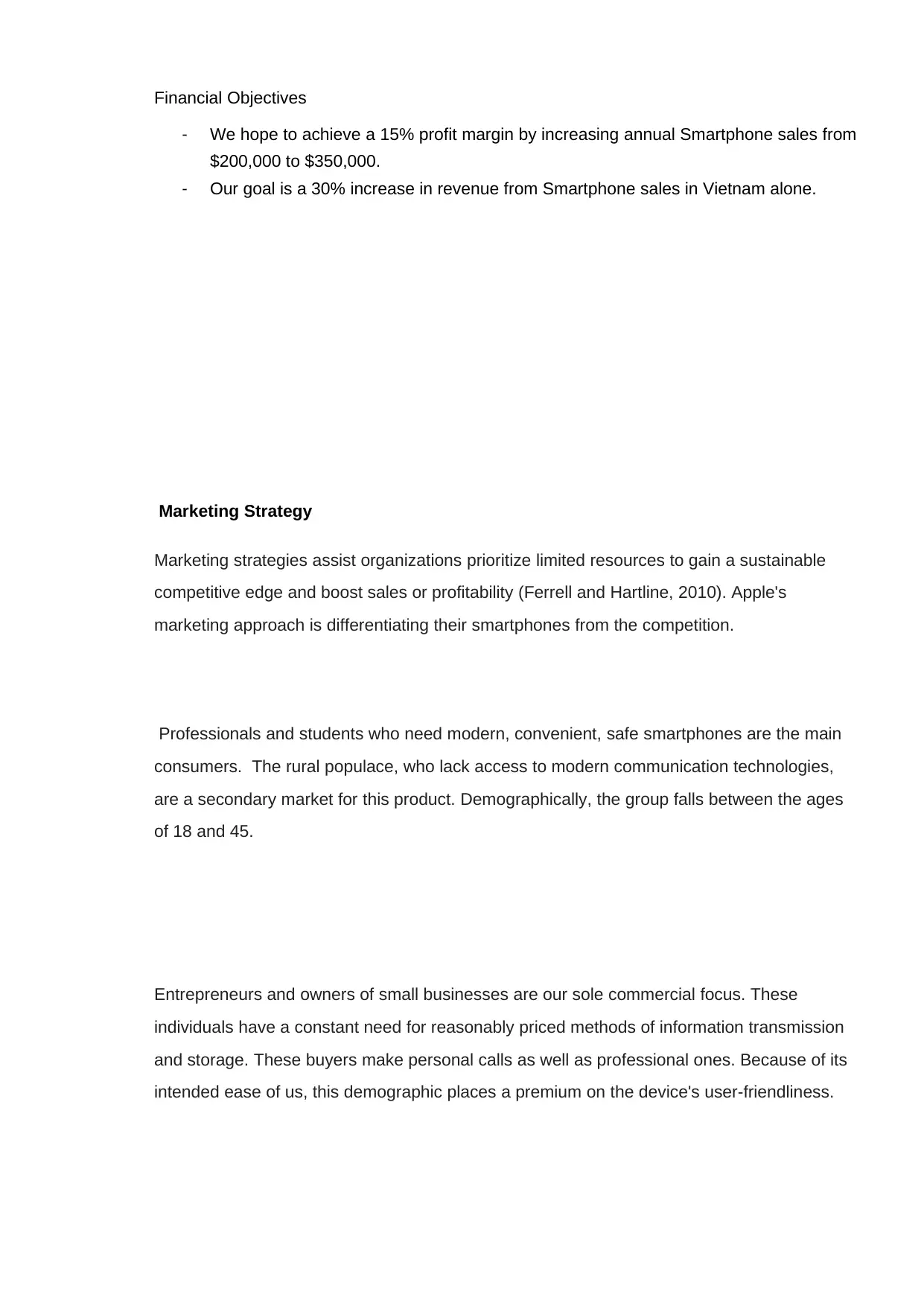
Financial Objectives
- We hope to achieve a 15% profit margin by increasing annual Smartphone sales from
$200,000 to $350,000.
- Our goal is a 30% increase in revenue from Smartphone sales in Vietnam alone.
Marketing Strategy
Marketing strategies assist organizations prioritize limited resources to gain a sustainable
competitive edge and boost sales or profitability (Ferrell and Hartline, 2010). Apple's
marketing approach is differentiating their smartphones from the competition.
Professionals and students who need modern, convenient, safe smartphones are the main
consumers. The rural populace, who lack access to modern communication technologies,
are a secondary market for this product. Demographically, the group falls between the ages
of 18 and 45.
Entrepreneurs and owners of small businesses are our sole commercial focus. These
individuals have a constant need for reasonably priced methods of information transmission
and storage. These buyers make personal calls as well as professional ones. Because of its
intended ease of us, this demographic places a premium on the device's user-friendliness.
- We hope to achieve a 15% profit margin by increasing annual Smartphone sales from
$200,000 to $350,000.
- Our goal is a 30% increase in revenue from Smartphone sales in Vietnam alone.
Marketing Strategy
Marketing strategies assist organizations prioritize limited resources to gain a sustainable
competitive edge and boost sales or profitability (Ferrell and Hartline, 2010). Apple's
marketing approach is differentiating their smartphones from the competition.
Professionals and students who need modern, convenient, safe smartphones are the main
consumers. The rural populace, who lack access to modern communication technologies,
are a secondary market for this product. Demographically, the group falls between the ages
of 18 and 45.
Entrepreneurs and owners of small businesses are our sole commercial focus. These
individuals have a constant need for reasonably priced methods of information transmission
and storage. These buyers make personal calls as well as professional ones. Because of its
intended ease of us, this demographic places a premium on the device's user-friendliness.
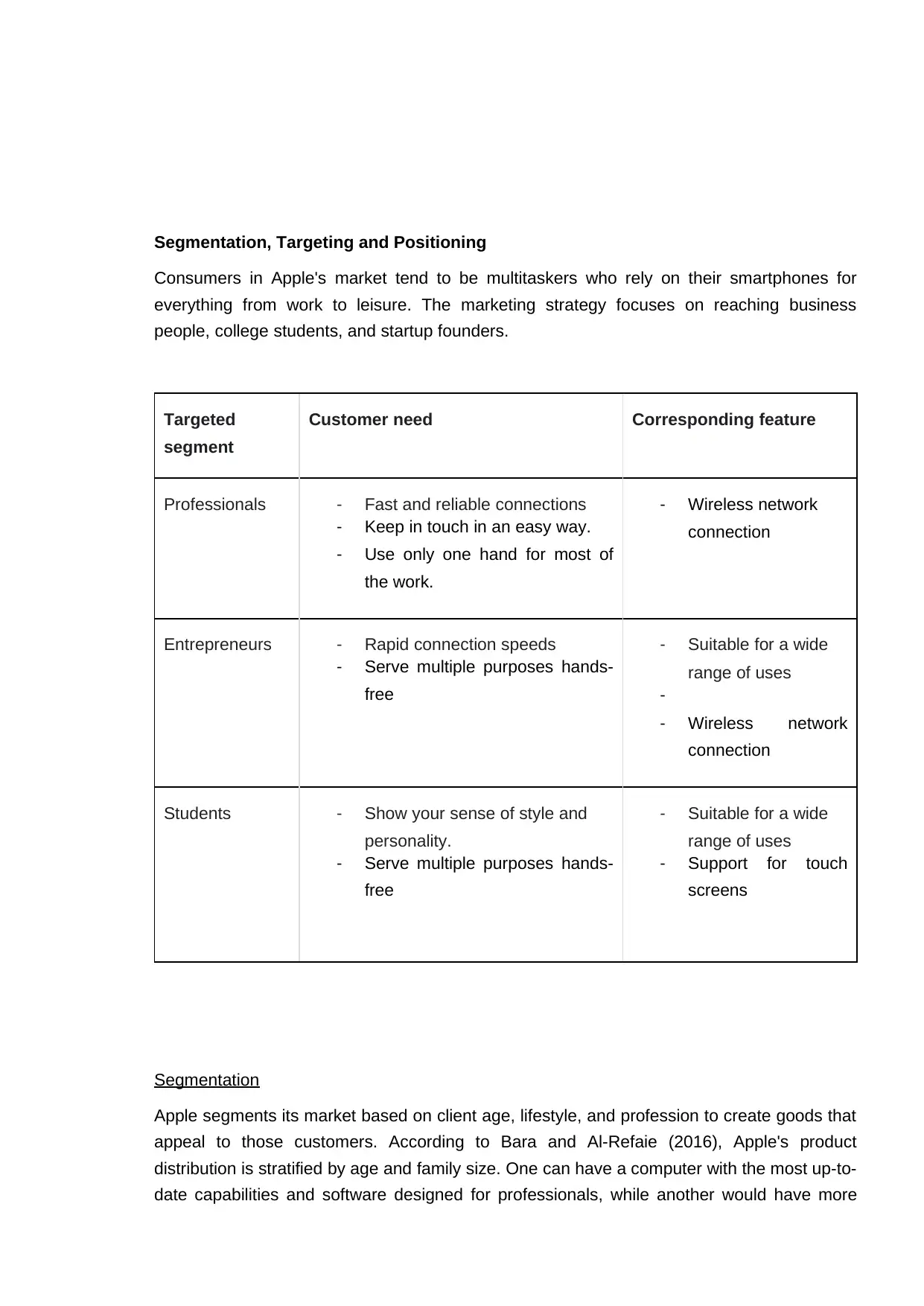
Segmentation, Targeting and Positioning
Consumers in Apple's market tend to be multitaskers who rely on their smartphones for
everything from work to leisure. The marketing strategy focuses on reaching business
people, college students, and startup founders.
Targeted
segment
Customer need Corresponding feature
Professionals - Fast and reliable connections
- Keep in touch in an easy way.
- Use only one hand for most of
the work.
- Wireless network
connection
Entrepreneurs - Rapid connection speeds
- Serve multiple purposes hands-
free
- Suitable for a wide
range of uses
-
- Wireless network
connection
Students - Show your sense of style and
personality.
- Serve multiple purposes hands-
free
- Suitable for a wide
range of uses
- Support for touch
screens
Segmentation
Apple segments its market based on client age, lifestyle, and profession to create goods that
appeal to those customers. According to Bara and Al-Refaie (2016), Apple's product
distribution is stratified by age and family size. One can have a computer with the most up-to-
date capabilities and software designed for professionals, while another would have more
Consumers in Apple's market tend to be multitaskers who rely on their smartphones for
everything from work to leisure. The marketing strategy focuses on reaching business
people, college students, and startup founders.
Targeted
segment
Customer need Corresponding feature
Professionals - Fast and reliable connections
- Keep in touch in an easy way.
- Use only one hand for most of
the work.
- Wireless network
connection
Entrepreneurs - Rapid connection speeds
- Serve multiple purposes hands-
free
- Suitable for a wide
range of uses
-
- Wireless network
connection
Students - Show your sense of style and
personality.
- Serve multiple purposes hands-
free
- Suitable for a wide
range of uses
- Support for touch
screens
Segmentation
Apple segments its market based on client age, lifestyle, and profession to create goods that
appeal to those customers. According to Bara and Al-Refaie (2016), Apple's product
distribution is stratified by age and family size. One can have a computer with the most up-to-
date capabilities and software designed for professionals, while another would have more
⊘ This is a preview!⊘
Do you want full access?
Subscribe today to unlock all pages.

Trusted by 1+ million students worldwide
1 out of 26
Your All-in-One AI-Powered Toolkit for Academic Success.
+13062052269
info@desklib.com
Available 24*7 on WhatsApp / Email
![[object Object]](/_next/static/media/star-bottom.7253800d.svg)
Unlock your academic potential
Copyright © 2020–2025 A2Z Services. All Rights Reserved. Developed and managed by ZUCOL.


